Study and Microanalysis on the Effect of the Addition of Polypropylene Fibres on the Bending Strength and Carbonization Resistance of Manufactured Sand Concrete
Abstract
1. Introduction
2. Materials and Methods
2.1. Raw Materials
2.2. Mix Proportion Design and Specimen Fabrication
2.3. Test Scheme
3. Results and Discussion
3.1. Analysis of the Bending Strength
3.2. Analysis of Carbonization Resistance
3.3. Carbonization Depth Prediction Model
3.4. Establishment and Analysis of an RSM
4. Microanalysis
4.1. Phase Composition Testing and Analysis
4.2. Microstructure Analysis
5. Conclusions
Author Contributions
Funding
Data Availability Statement
Acknowledgments
Conflicts of Interest
References
- Monteiro, P.J.M.; Miller, S.A.; Horvath, A. Towards sustainable concrete. Nat. Mater. 2017, 16, 698–699. [Google Scholar] [CrossRef]
- Brito, D.J.; Kurda, R. The past and future of sustainable concrete: A critical review and new strategies on cement-based materials. J. Clean. Prod. 2021, 281, 123558. [Google Scholar] [CrossRef]
- Ghahari, S.A.; Assi, L.N.; Alsalman, A.; Alyamaç, K.E. Fracture properties evaluation of cellulose nanocrystals cement paste. Materials 2020, 13, 2507. [Google Scholar] [CrossRef]
- Pedro, D.; De, B.J.; Evangelista, L. Mechanical characterization of high performance concrete prepared with recycled aggregates and silica fume from precast industry. J. Clean. Prod. 2017, 164, 939–949. [Google Scholar] [CrossRef]
- United Nations Environment Programme (UNEP). Rising Demand for Sand Calls for Resource Governance; UNEP: Nairobi, Kenya, 2019. [Google Scholar]
- Koehnken, L.; Rintoul, M.S.; Goichot, M.; Tickner, D.; Loftus, A.C.; Acreman, M.C. Impacts of riverine sand mining on freshwater ecosystems: A review of the scientific evidence and guidance for future research. River Res. Appl. 2020, 36, 362–370. [Google Scholar] [CrossRef]
- Shi, C.; Li, Y.; Zhang, J.; Li, W.; Chong, L.; Xie, Z. Performance enhancement of recycled concrete aggregate—A review. J. Clean. Prod. 2016, 112, 466–472. [Google Scholar] [CrossRef]
- Zhang, Y.; Shen, W.; Wu, M.; Shen, B.; Li, M.; Xu, G.; Zhang, B.L.; Ding, Q.J.; Chen, X. Experimental study on the utilization of copper tailing as micronized sand to prepare high performance concrete. Constr. Build. Mater. 2020, 244, 118312. [Google Scholar] [CrossRef]
- Rajan, B.; Singh, D. Understanding influence of crushers on shape characteristics of fine aggregates based on digital image and conventional techniques. Constr. Build. Mater. 2017, 150, 833–843. [Google Scholar] [CrossRef]
- Zhang, Y.; Gu, L.; Zhang, Q. Durability of manufactured sand concrete in atmospheric acidification environment. Case Stud. Constr. Mater. 2022, 17, e01613. [Google Scholar] [CrossRef]
- Devadass, T. Experimental study on replacement of fine aggregate in concrete with dissimilar curing conditions. Case Stud. Constr. Mater. 2019, 11, e00245. [Google Scholar] [CrossRef]
- Zhang, D.; Yang, Q.; Mao, M.; Li, J. Carbonation performance of concrete with fly ash as fine aggregate after stress damage and high temperature exposure. Constr. Build. Mater. 2020, 242, 118125. [Google Scholar] [CrossRef]
- Akhila, J.; Rao, N.V. Experimental Investigation on Carbonation of Concrete Using SEM–EDX (Scanning Electron Microscopy (SEM) with Energy Dispersive X-ray Analysis (EDX) & Environmental Scanning Electron Microscope (ESEM) Analysis. Conf. Ser. Earth Environ. Sci. 2023, 1130, 012022. [Google Scholar]
- Vijaya, B. Microstructural study on the concrete containing manufactured sand. J. Crit. Rev. 2020, 7, 1560–1564. [Google Scholar]
- Zhao, S.B.; Li, Y.T.; Xu, Y.Y. Study on Durability of Concrete with Machine-Made Sand Part II: Long-Term Carbonization. Appl. Mech. Mater. 2013, 438, 10–14. [Google Scholar] [CrossRef]
- Ramesh, B.; Gokulnath, V.; Vijayavignesh, V. A review on fiber reinforced self compacting concrete addition with M-Sand. Mater. Today Proc. 2020, 22, 1097–1102. [Google Scholar] [CrossRef]
- Mundra, S.; Sindhi, P.R.; Chandwani, V.; Nagar, R.; Agrawal, V. Crushed rock sand—An economical and ecological alternative to natural sand to optimize concrete mix. Perspect. Sci. 2016, 8, 345–347. [Google Scholar] [CrossRef]
- Meisuh, B.K.; Kankam, C.K.; Buabin, T.K. Effect of quarry rock dust on the flexural strength of concrete. Case Stud. Constr. Mater. 2018, 8, 16–22. [Google Scholar] [CrossRef]
- Sangoju, B.; Ramesh, G.; Bharatkumar, B.H.; Ramanjaneyulu, K. Evaluation of durability parameters of concrete with manufacture sand and river sand. J. Inst. Eng. India Ser. A 2017, 98, 267–275. [Google Scholar] [CrossRef]
- Dhanesh, S.; Kumar, K.S.; Maruthur, P.; Rejumon, R.; Usmansha, G.S. Experimental investigation of strength of Aramid kelvar and chopped carbon reinforced concrete beam. Mater. Today Proc. 2021, 45, 1269–1273. [Google Scholar] [CrossRef]
- Dong, L.F.; Zhang, S.P. Effect of steel fiber on comprehensive performance of concrete materials. Appl. Mech. Mater. 2015, 723, 440–444. [Google Scholar] [CrossRef]
- Zhang, P.; Li, Q.F. Combined effect of polypropylene fiber and silica fume on workability and carbonation resistance of concrete composite containing fly ash. Compos. Part B Eng. 2013, 227, 250–258. [Google Scholar] [CrossRef]
- Muflikhun, M.A.; Yokozeki, T. Experimental and numerical analysis of CFRP-SPCC hybrid laminates for automotive and structural applications with cost analysis assessment. Compos. Struct. 2021, 263, 113707. [Google Scholar] [CrossRef]
- Das, C.S.; Dey, T.; Dandapat, R.; Mukharjee, B.B.; Kumar, J. Performance evaluation of polypropylene fibre reinforced recycled aggregate concrete. Constr. Build. Mater. 2018, 189, 649–659. [Google Scholar] [CrossRef]
- Hiremath, P.N.; Yaragal, S.C. Performance evaluation of reactive powder concrete with polypropylene fibers at elevated temperatures. Constr. Build. Mater. 2018, 169, 499–512. [Google Scholar] [CrossRef]
- Nili, M.; Afroughsabet, V. The effects of silica fume and polypropylene fibers on the impact resistance and mechanical properties of concrete. Constr. Build. Mater. 2010, 24, 927–933. [Google Scholar] [CrossRef]
- Matar, P.; Assaad, J.J. Concurrent effects of recycled aggregates and polypropylene fibers on workability and key strength properties of self-consolidating concrete. Constr. Build. Mater. 2019, 199, 492–500. [Google Scholar] [CrossRef]
- Lu, G.; Zhao, W.; Dai, D. Study on Preparation of cementitious capillary crystalline waterproofing coating. In Proceedings of the 3rd International Conference on Mechatronics, Robotics and Automation, Shenzhen, China, 14–15 May 2015; pp. 79–84. [Google Scholar]
- Bagherzadeh, R.; Sadeghi, A.H.; Latifi, M. Utilizing polypropylene fibers to improve physical and mechanical properties of concrete. Text. Res. J. 2012, 82, 88–96. [Google Scholar] [CrossRef]
- Söylev, T.A.; Özturan, T. Durability, physical and mechanical properties of fiber-reinforced concretes at low-volume fraction. Constr. Build. Mater. 2014, 73, 67–75. [Google Scholar] [CrossRef]
- Venkatesan, R.C.S.; Patnaikuni, I. Review on hybrid fiber reinforced high performance high volume flyash concrete. Int. J. Struct. Civ. Eng. Res. 2016, 5, 39–43. [Google Scholar]
- Olivier, G.; Combrinck, R.; Kayondo, M.; Boshoff, W.P. Combined effect of nano-silica, super absorbent polymers, and synthetic fibres on plastic shrinkage cracking in concrete. Constr. Build. Mater. 2018, 192, 85–98. [Google Scholar] [CrossRef]
- Bolat, H.; Şimşek, O.; Çullu, M.; Can, Ö. The effects of macro synthetic fiber reinforcement use on physical and mechanical properties of concrete. Compos. Part B Eng. 2014, 61, 191–198. [Google Scholar] [CrossRef]
- Xu, L.; Deng, F.; Chi, Y. Nano-mechanical behavior of the interfacial transition zone between steel-polypropylene fiber and cement paste. Constr. Build. Mater. 2017, 145, 619–638. [Google Scholar] [CrossRef]
- Qin, Y.; Zhang, X.; Chai, J.; Xu, Z.; Li, S. Experimental study of compressive behavior of polypropylene-fiber-reinforced and polypropylene-fiber-fabric-reinforced concrete. Constr. Build. Mater. 2019, 194, 216–225. [Google Scholar] [CrossRef]
- Yew, M.K.; Mahmud, H.B.; Ang, B.C.; Yew, M.C. Influence of different types of polypropylene fibre on the mechanical properties of high-strength oil palm shell lightweight concrete. Constr. Build. Mater. 2015, 90, 36–43. [Google Scholar] [CrossRef]
- Afroughsabet, V.; Ozbakkaloglu, T. Mechanical and durability properties of high-strength concrete containing steel and polypropylene fibers. Constr. Build. Mater. 2015, 94, 73–82. [Google Scholar] [CrossRef]
- Ramezanianpour, A.A.; Esmaeili, M.; Ghahari, S.A.; Najafi, M.H. Laboratory study on the effect of polypropylene fiber on durability, and physical and mechanical characteristic of concrete for application in sleepers. Constr. Build. Mater. 2013, 44, 411–418. [Google Scholar] [CrossRef]
- Frazão, C.; Camões, A.; Barros, J.; Gonçalves, D. Durability of steel fiber reinforced self-compacting concrete. Constr. Build. Mater. 2015, 80, 155–166. [Google Scholar] [CrossRef]
- Małek, M.; Jackowski, M.; Łasica, W.; Kadela, M. Characteristics of recycled polypropylene fibers as an addition to concrete fabrication based on portland cement. Materials 2020, 13, 1827. [Google Scholar] [CrossRef] [PubMed]
- Li, T.; Zhan, M.; Chen, X.; Xu, F.; Wang, S.; Liu, X. Study on Carbonization Characteristics and Deterioration Mechanism of Recycled Concrete with Tailings and Polypropylene Fiber. Polymers 2022, 14, 2758. [Google Scholar] [CrossRef]
- He, H.; Wang, Y.; Wang, J. Effects of aggregate micro fines (AMF), aluminum sulfate and polypropylene fiber (PPF) on properties of machine-made sand concrete. Appl. Sci. 2019, 9, 2250. [Google Scholar] [CrossRef]
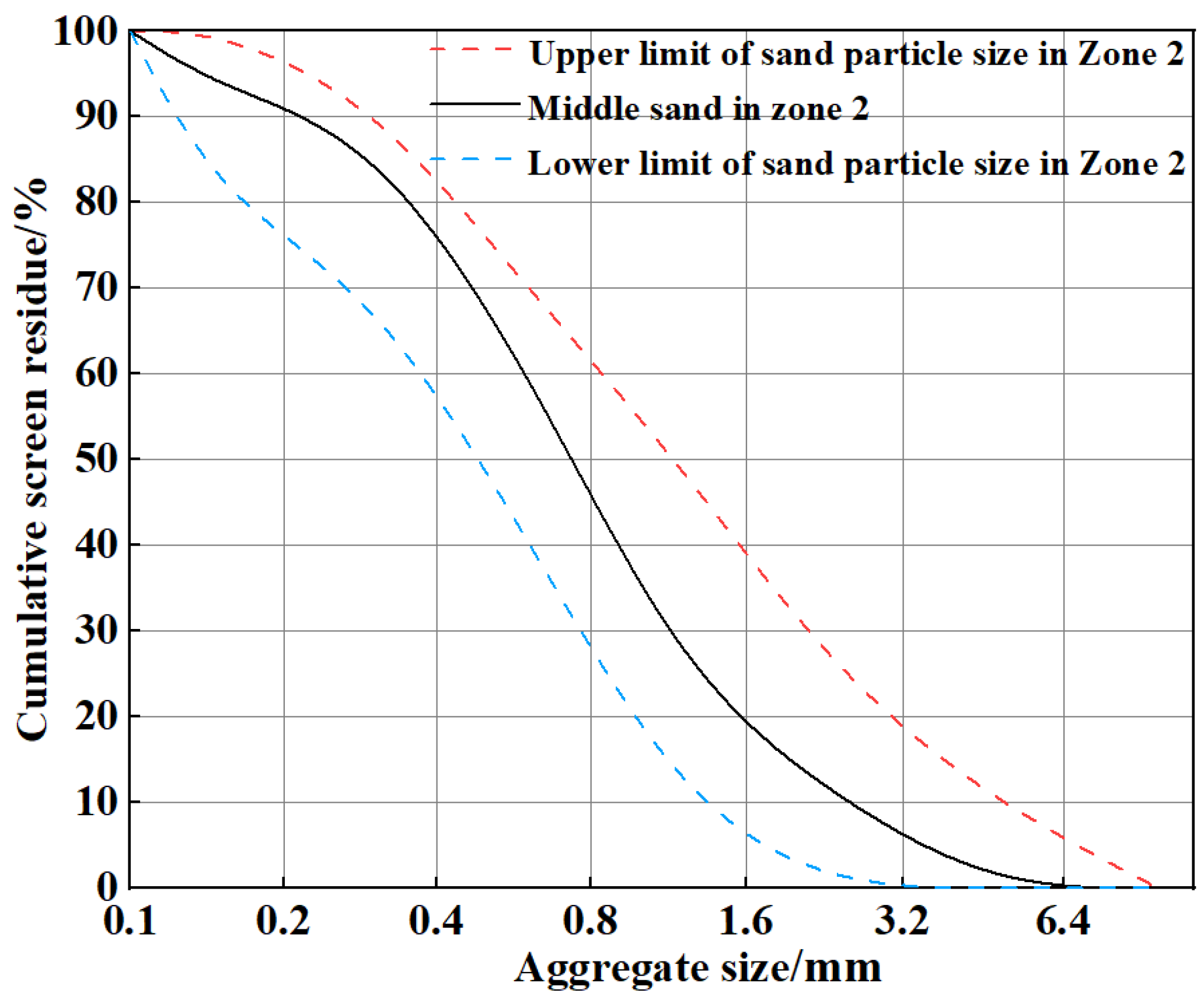

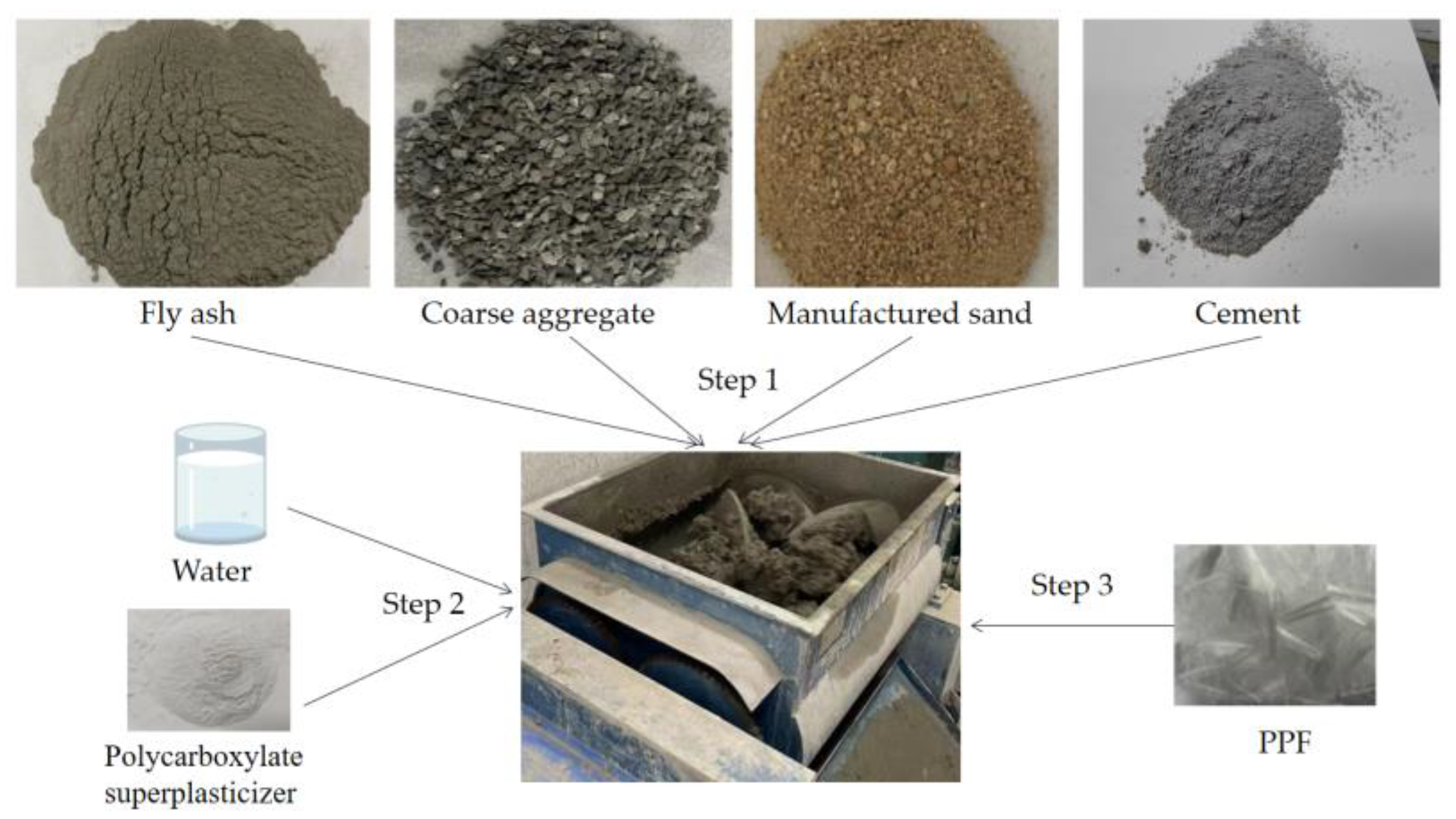
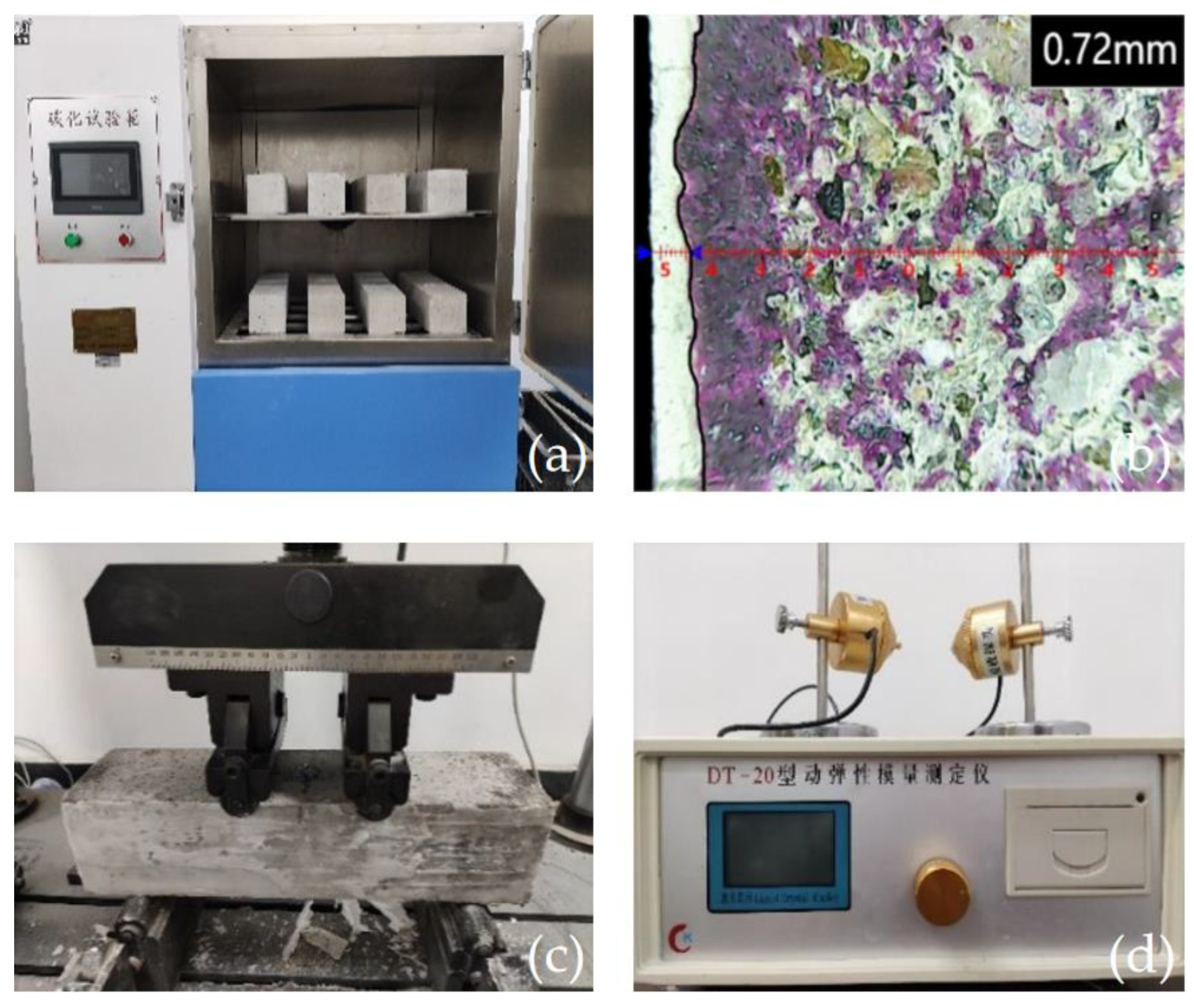
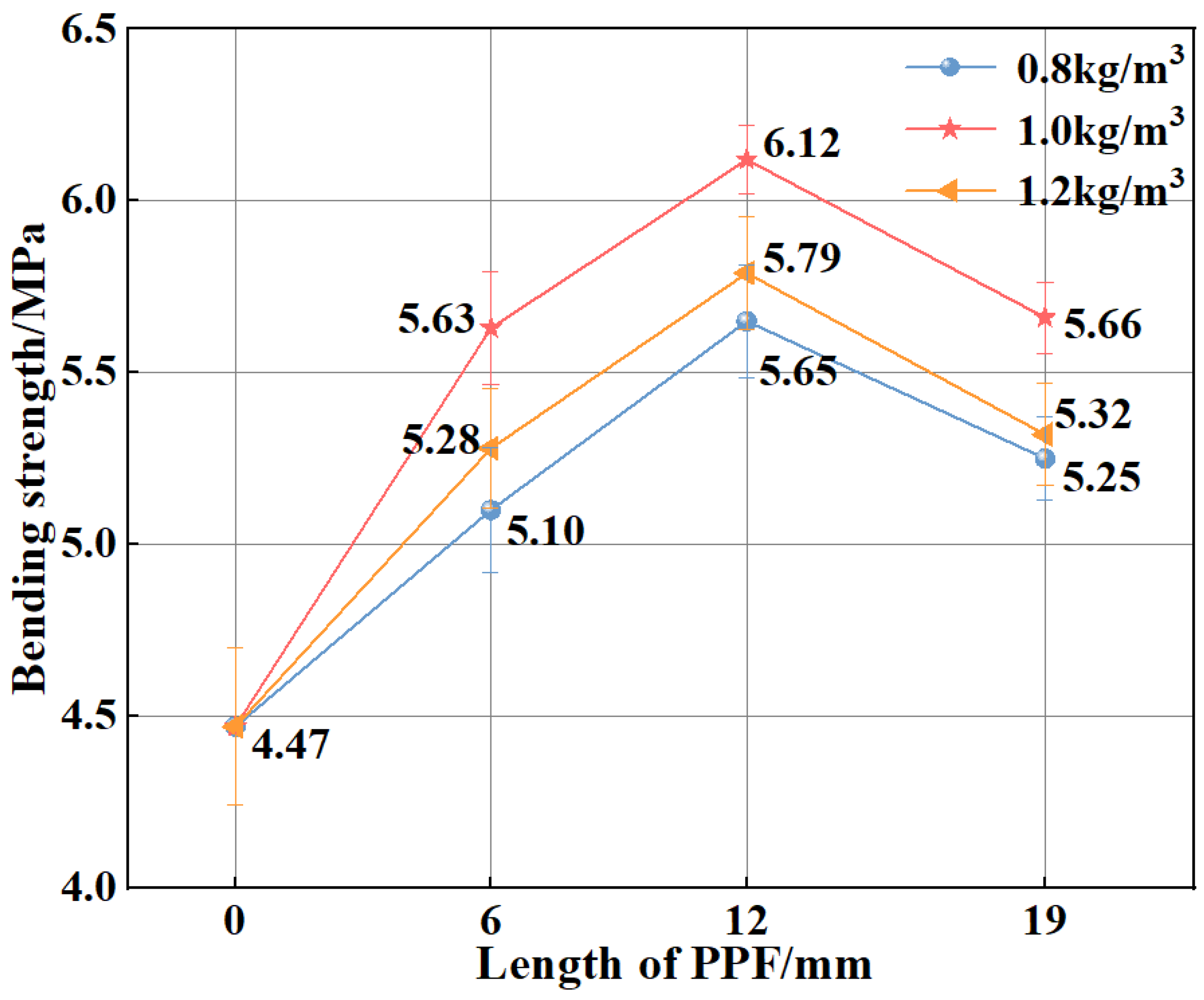

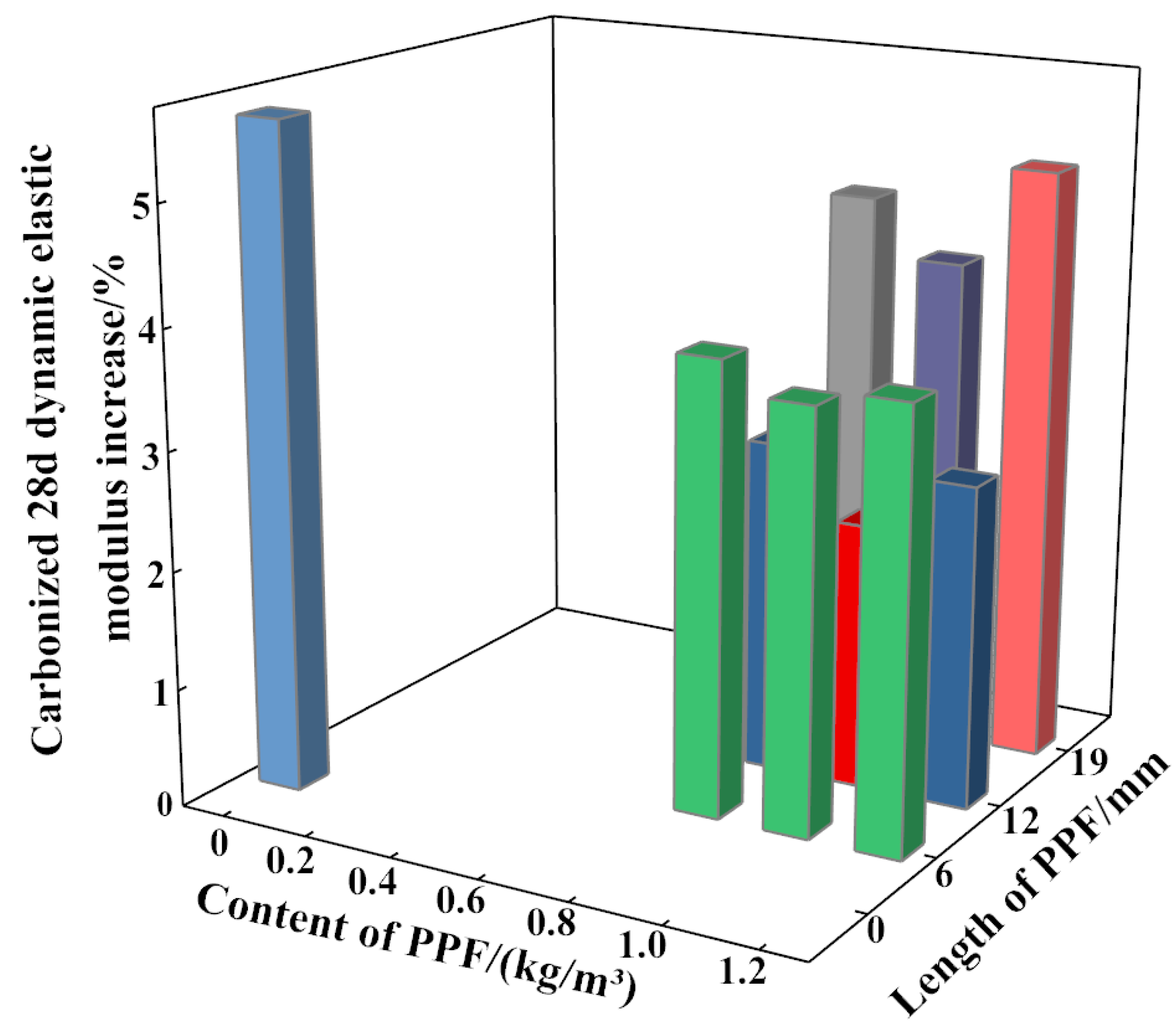
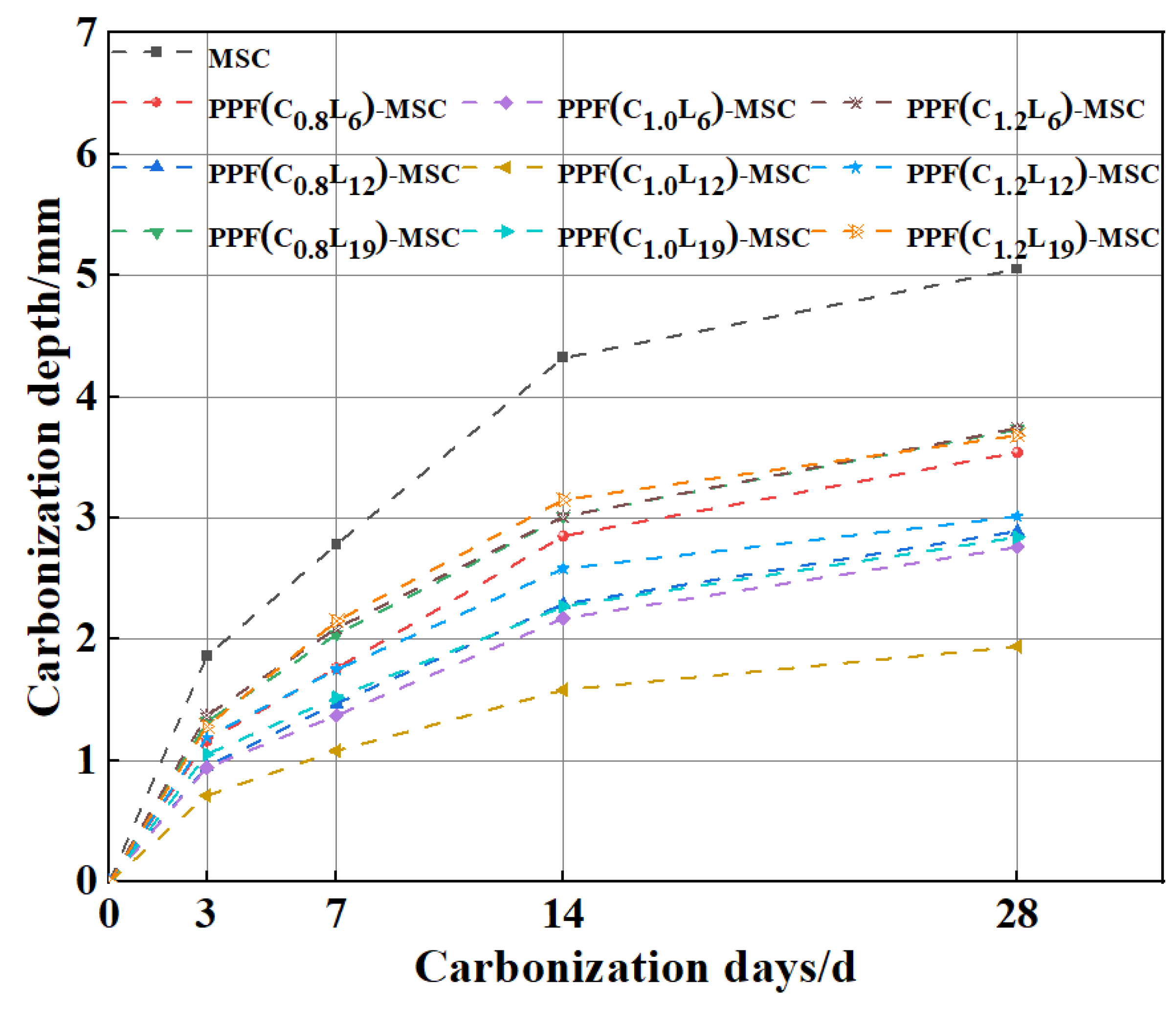
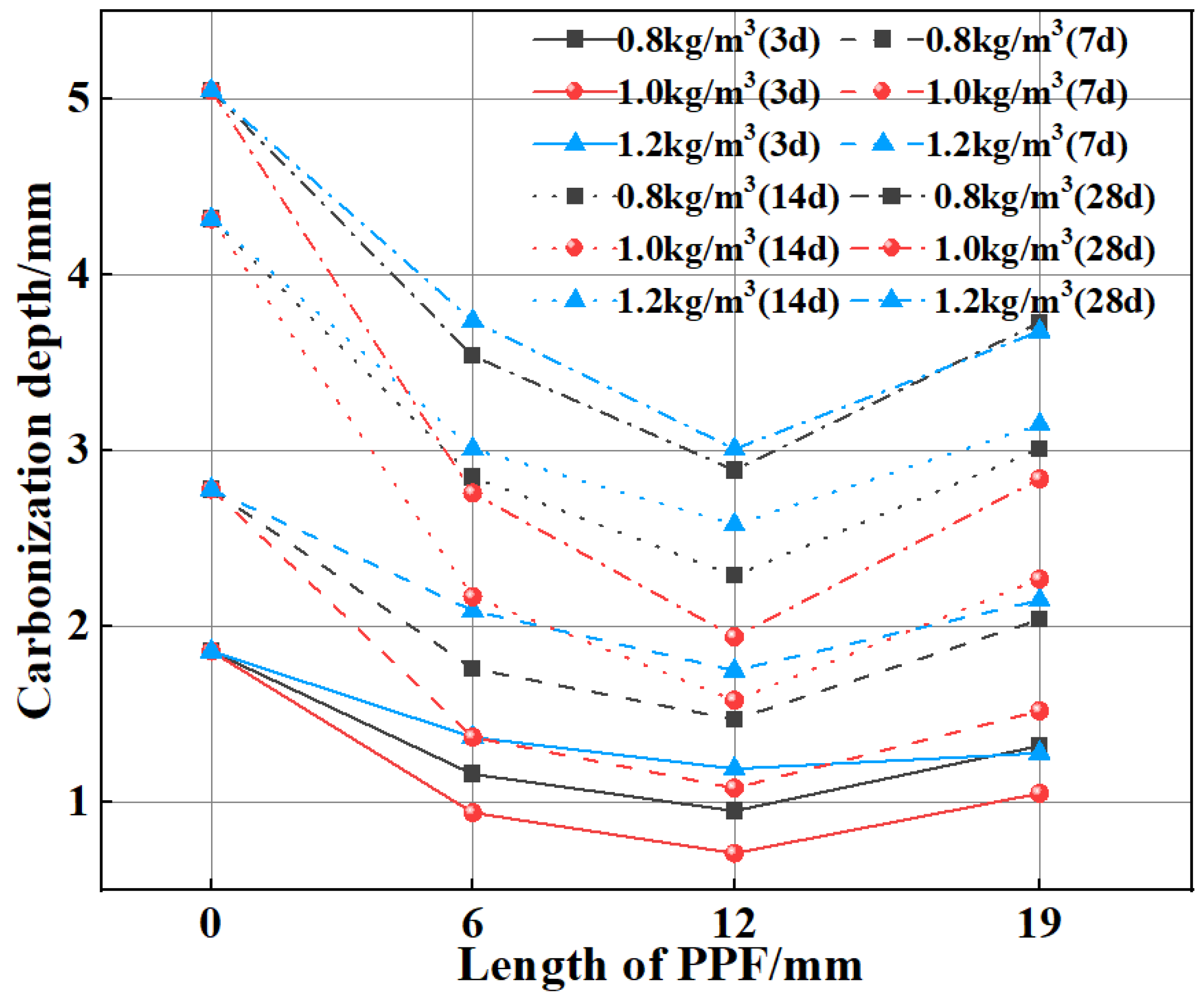
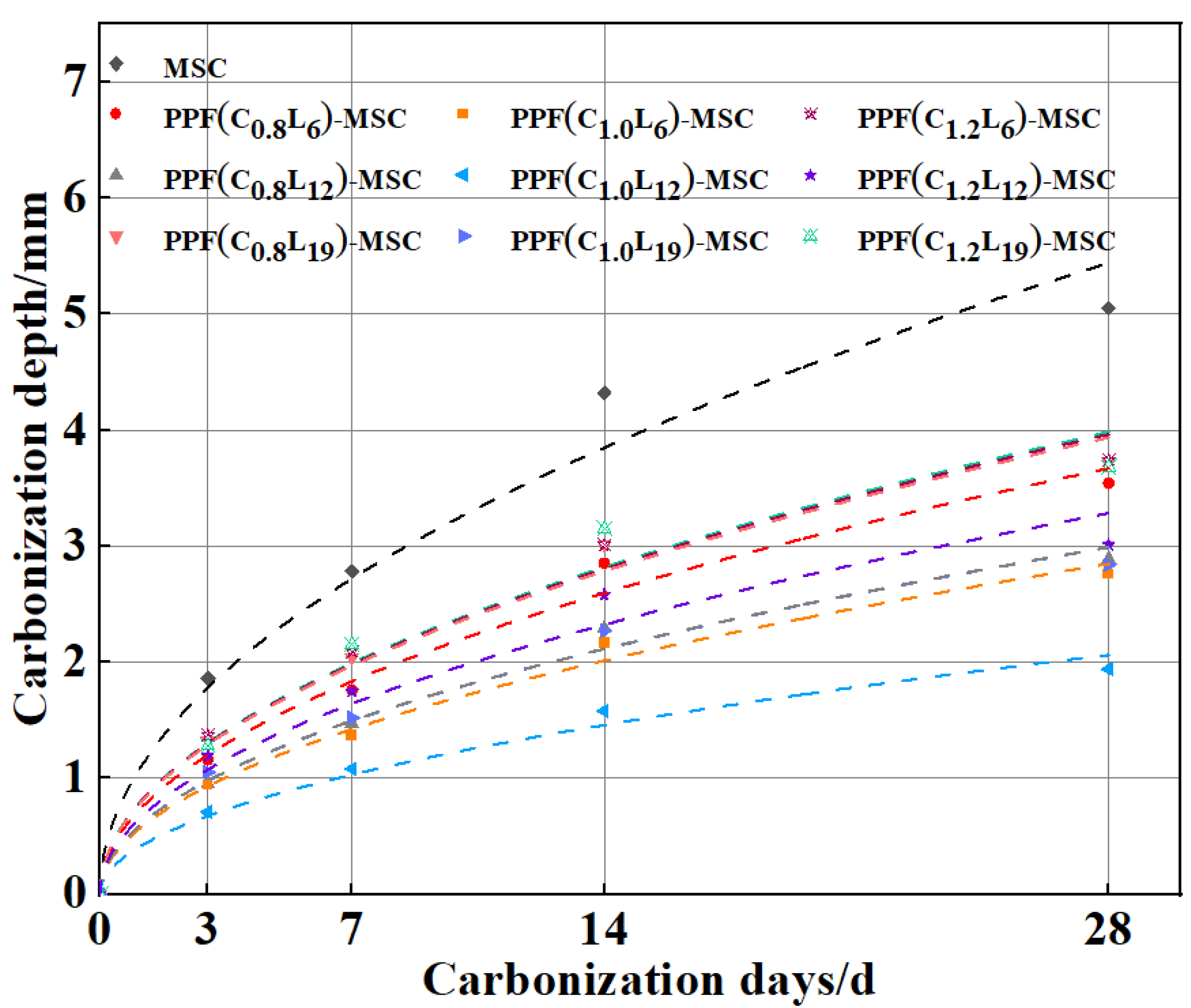
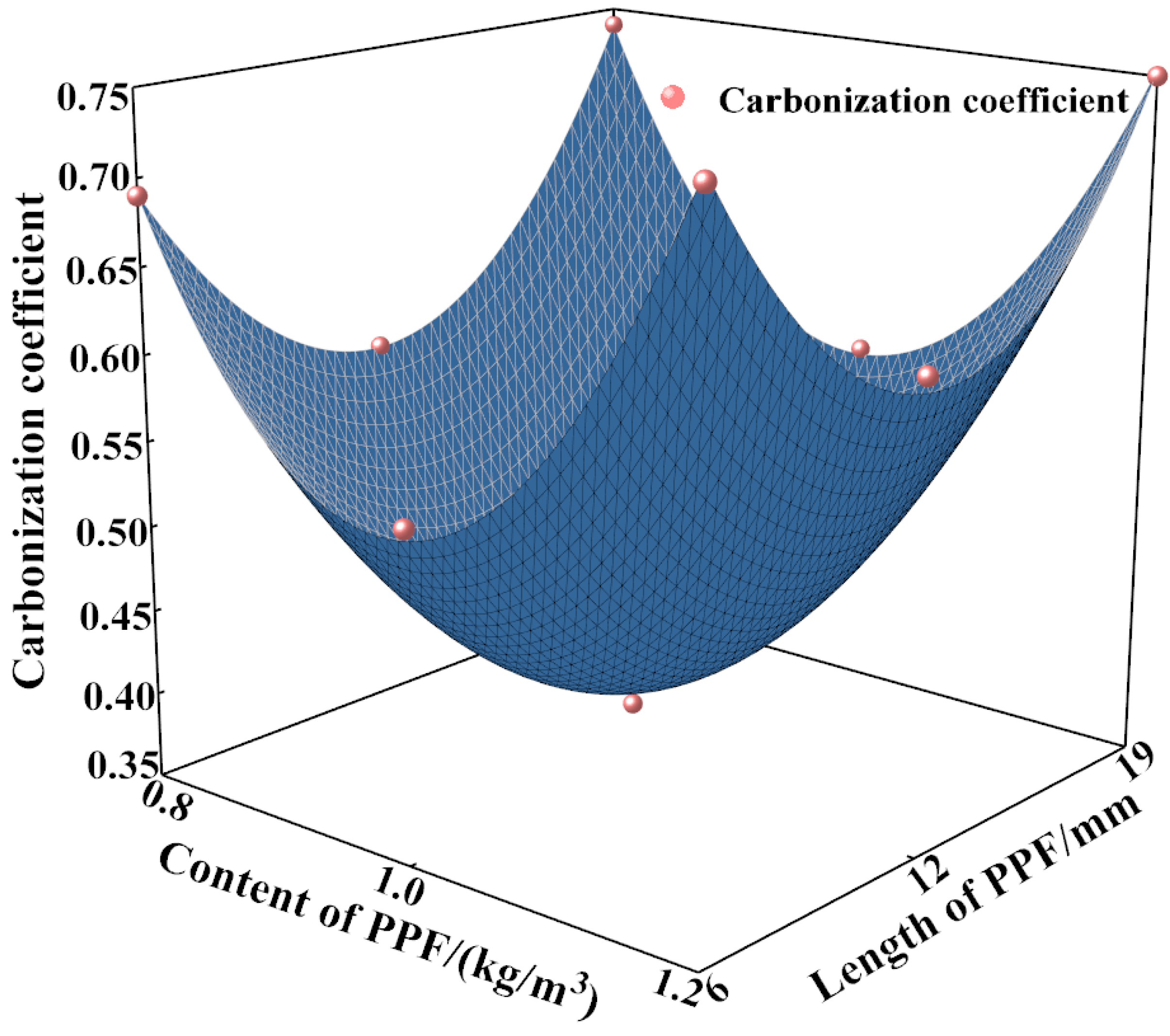

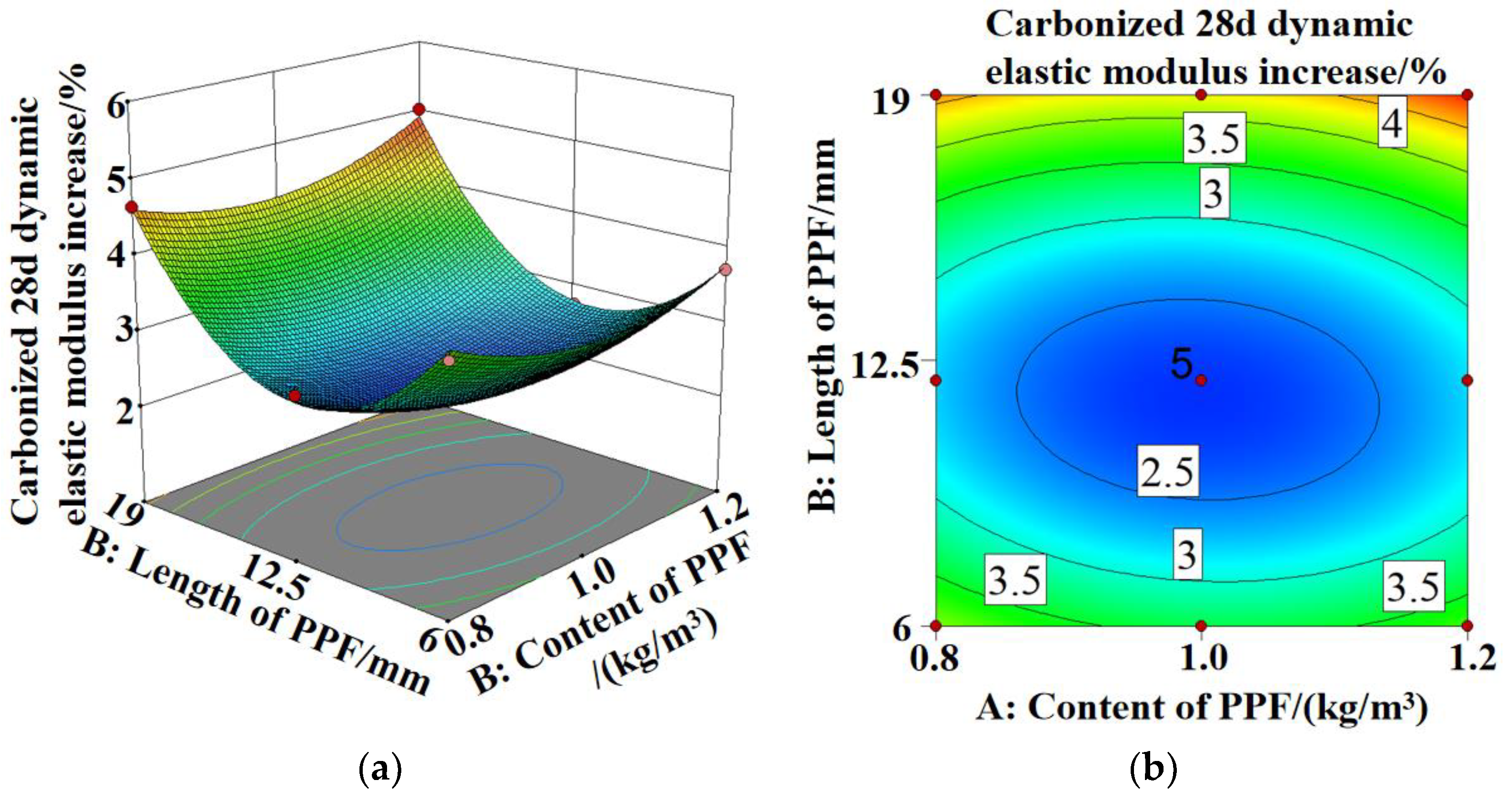
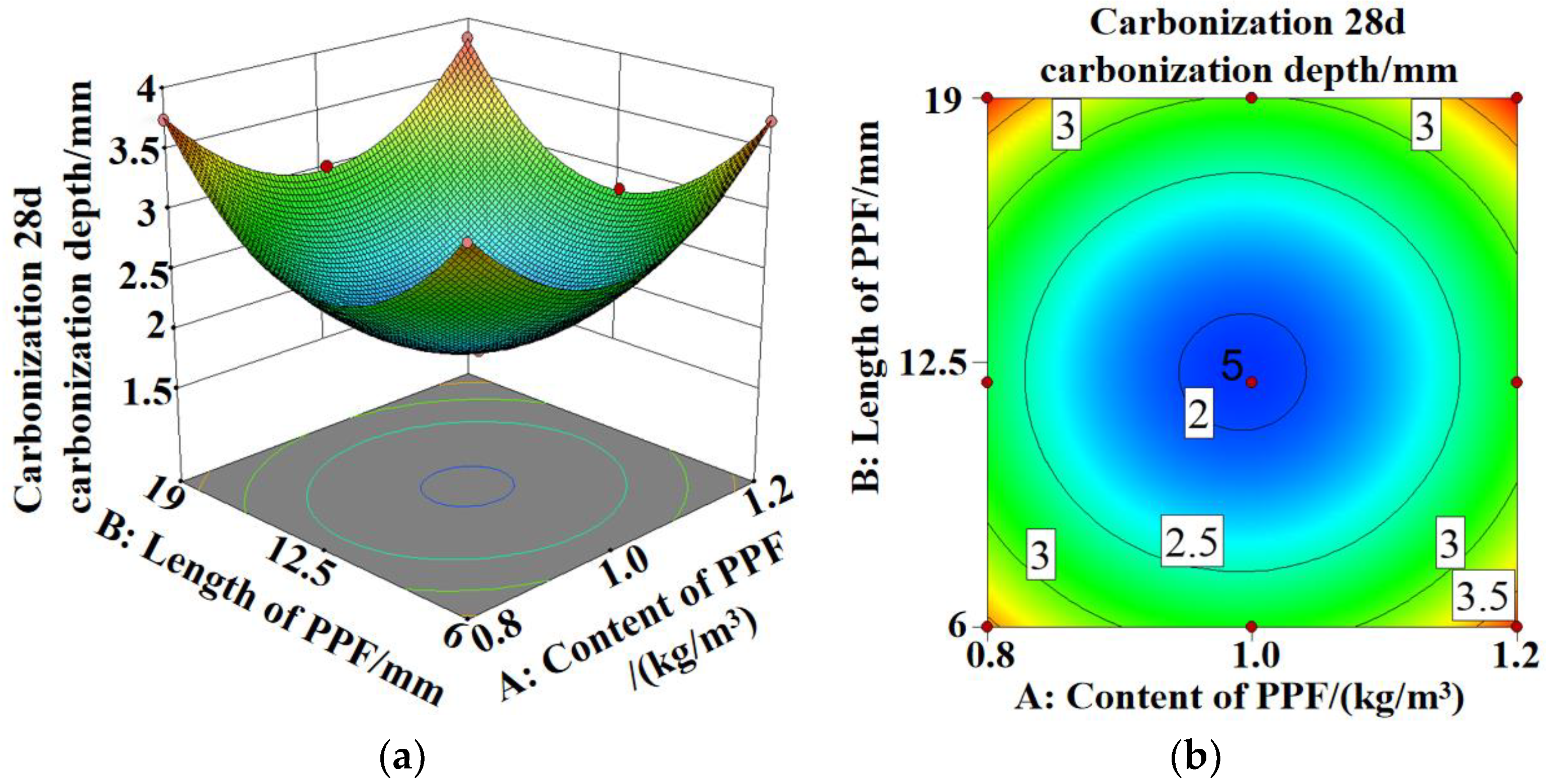

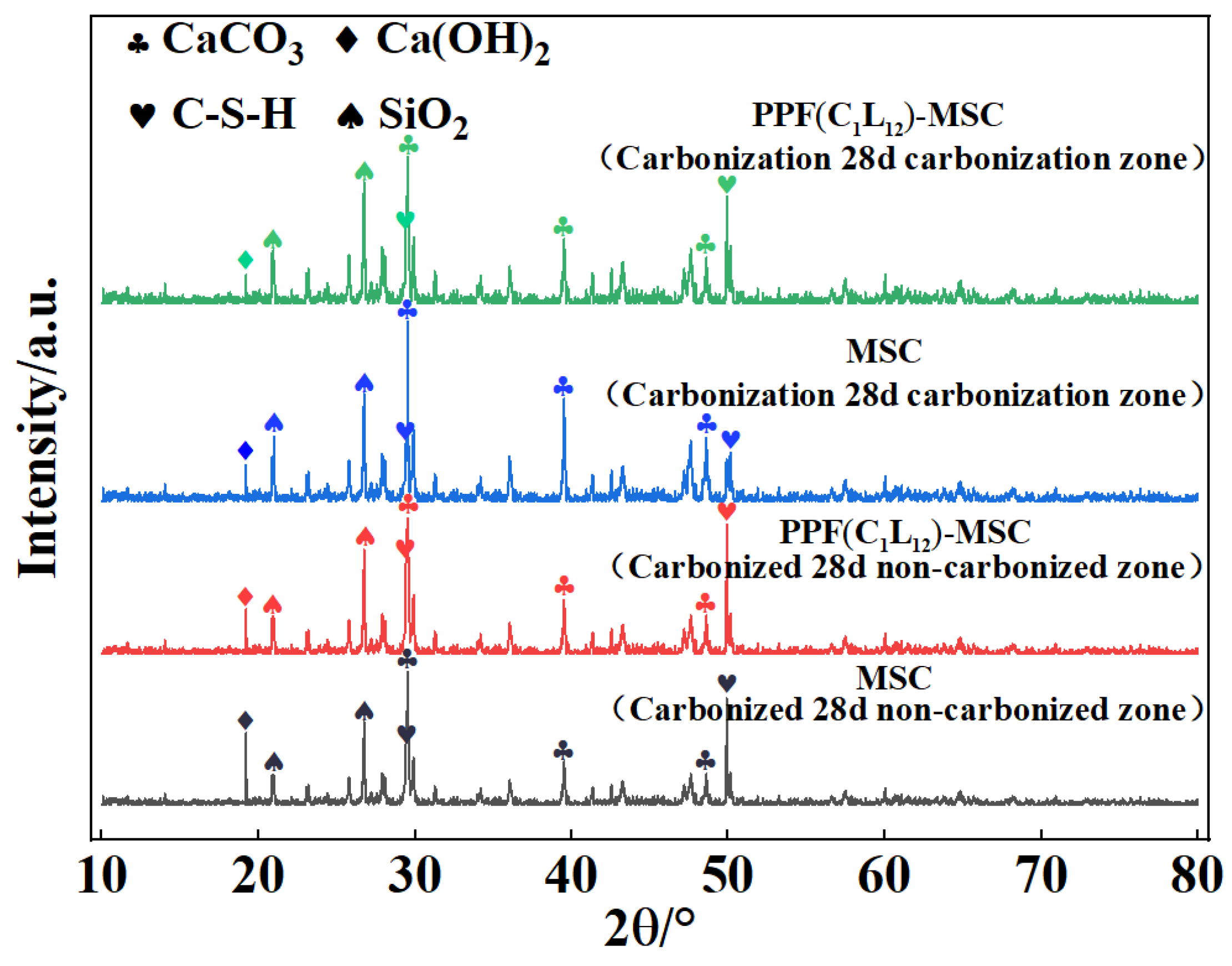

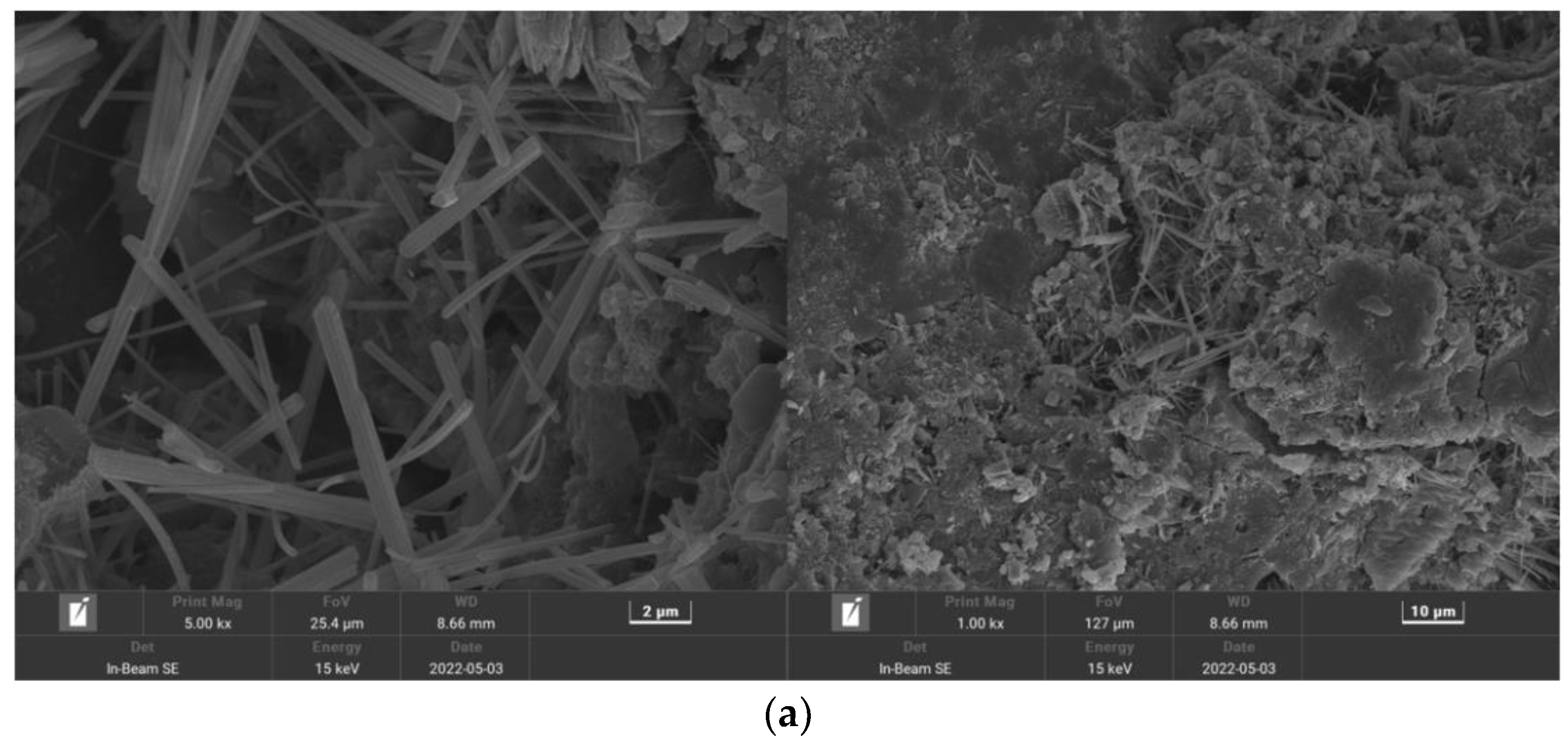
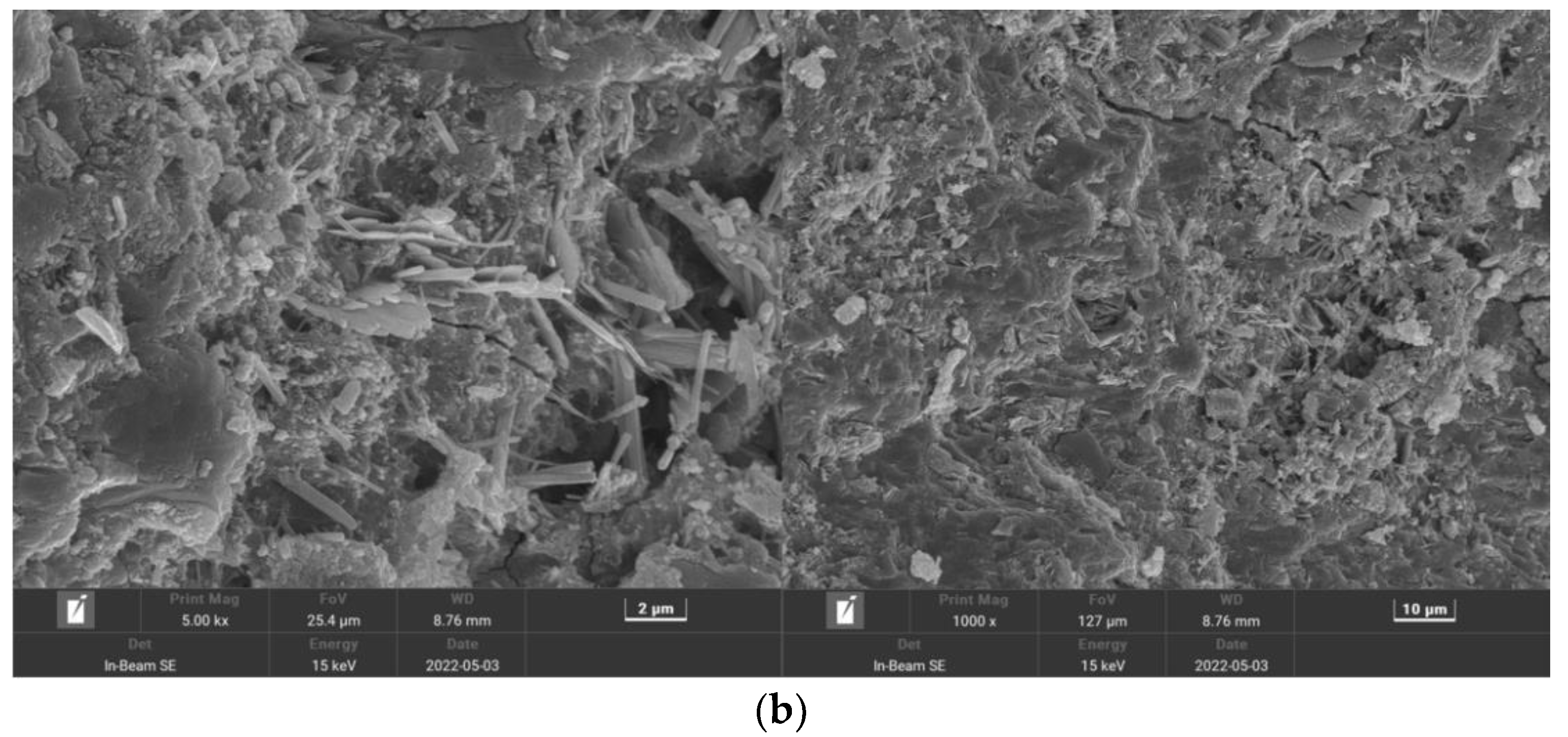
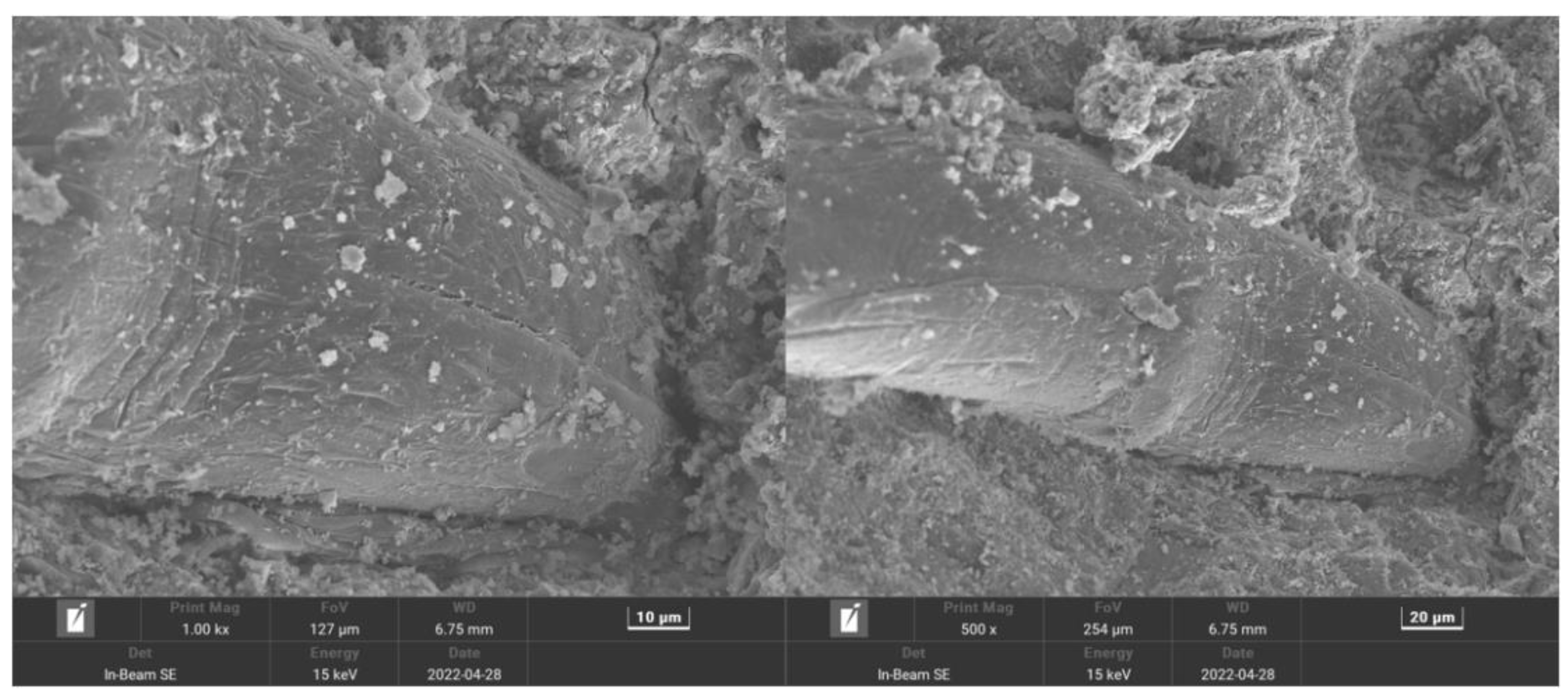
| Fine Aggregate | Apparent Density (kg/m3) | Fineness | Bulk Density (kg/m3) | Silt Content (%) |
|---|---|---|---|---|
| Manufactured sand | 2610 | 2.6~2.8 | 1500 | 1.8 |
| Type | Density (g/cm3) | Elasticity Modulus (MPa) | Breaking Strength (MPa) | Elongation at Break (%) | Melting Point (°C) | Ignition Point (°C) | Acid and Alkali Resistance |
|---|---|---|---|---|---|---|---|
| Fascicular | 0.91 | >4500 | 450 | 25 ± 5 | 165–175 | 590 | Strong |
| No. | Fibre Content (kg/m3) | Fibre Length (mm) | Consumption of Materials (kg/m3) | |||||
|---|---|---|---|---|---|---|---|---|
| Cement | Fly Ash | Manufactured Sand | Gravel | Water | Water Reducer | |||
| MSC | 0 | 0 | 398 | 80 | 763 | 920 | 200 | 4.71 |
| PPF(C0.8L6)-MSC | 0.8 | 6 | 398 | 80 | 763 | 920 | 200 | 4.71 |
| PPF(C0.8L12)-MSC | 0.8 | 12 | 398 | 80 | 763 | 920 | 200 | 4.71 |
| PPF(C0.8L19)-MSC | 0.8 | 19 | 398 | 80 | 763 | 920 | 200 | 4.71 |
| PPF(C1L6)-MSC | 1 | 6 | 398 | 80 | 763 | 920 | 200 | 4.71 |
| PPF(C1L12)-MSC | 1 | 12 | 398 | 80 | 763 | 920 | 200 | 4.71 |
| PPF(C1L19)-MSC | 1 | 19 | 398 | 80 | 763 | 920 | 200 | 4.71 |
| PPF(C1.2L6)-MSC | 1.2 | 6 | 398 | 80 | 763 | 920 | 200 | 4.71 |
| PPF(C1.2L12)-MSC | 1.2 | 12 | 398 | 80 | 763 | 920 | 200 | 4.71 |
| PPF(C1.2L19)-MSC | 1.2 | 19 | 398 | 80 | 763 | 920 | 200 | 4.71 |
| Fitting Formula | R2 | |
|---|---|---|
| MSC | H = 1.03 | 0.976 |
| PPF(C0.8L6)-MSC | H = 0.69 | 0.989 |
| PPF(C0.8L12)-MSC | H = 0.57 | 0.992 |
| PPF(C0.8L19)-MSC | H = 0.74 | 0.988 |
| PPF(C1L6)-MSC | H = 0.54 | 0.992 |
| PPF(C1L12)-MSC | H = 0.39 | 0.985 |
| PPF(C1L19)-MSC | H = 0.56 | 0.989 |
| PPF(C1.2L6)-MSC | H = 0.75 | 0.987 |
| PPF(C1.2L12)-MSC | H = 0.62 | 0.971 |
| PPF(C1.2L19)-MSC | H = 0.75 | 0.974 |
| No. | PPF Content (kg/m3) | PPF Length (mm) | Bending Strength (MPa) | Increase in the Dynamic Elastic Modulus after 28 Days of Carbonization (%) | Carbonization Depth after 28 Days of Carbonization (mm) |
|---|---|---|---|---|---|
| 1 | 0.8 | 6 | 5.1 | 3.84 | 3.54 |
| 2 | 1 | 6 | 5.63 | 3.58 | 2.89 |
| 3 | 1.2 | 6 | 5.28 | 3.72 | 3.73 |
| 4 | 0.8 | 12 | 5.65 | 2.83 | 2.76 |
| 5 | 1 | 12 | 6.12 | 2.15 | 2.03 |
| 6 | 1.2 | 12 | 5.79 | 2.74 | 2.84 |
| 7 | 0.8 | 19 | 5.25 | 4.65 | 3.74 |
| 8 | 1 | 19 | 5.66 | 4.17 | 3.01 |
| 9 | 1.2 | 19 | 5.32 | 5.03 | 3.82 |
| 10 | 1 | 12 | 6.15 | 2.26 | 1.94 |
| 11 | 1 | 12 | 6.08 | 2.45 | 1.86 |
| 12 | 1 | 12 | 6.17 | 2.16 | 1.97 |
| 13 | 1 | 12 | 6.02 | 2.38 | 1.91 |
| Response Value | Multiple Regression Equation |
|---|---|
| Bending strength | y1 = 6.12 + 0.064A + 0.037B − 0.028AB − 0.4A2 − 0.48B2 |
| Increase in the dynamic elastic modulus | y2 = 2.32 + 0.032A + 0.45B + 0.13AB + 0.47A2 + 1.54B2 |
| Carbonization depth | y3 = 1.96 + 0.058A + 0.068B − 0.027AB + 0.81A2 + 0.96B2 |
| Source of Variance | Sum of Squares | Degrees of Freedom (DOF) | Mean Square | F Value | p Value |
|---|---|---|---|---|---|
| Bending strength model | 1.720 | 5 | 0.346 | 151.47 | <0.0001 ** |
| A | 0.025 | 1 | 0.025 | 10.85 | 0.013 * |
| B | 0.008 | 1 | 0.008 | 3.53 | 0.102 |
| AB | 0.003 | 1 | 0.003 | 1.34 | 0.285 |
| Model for the increase in the dynamic elastic modulus | 11.70 | 5 | 2.34 | 101.70 | <0.0001 ** |
| A | 0.006 | 1 | 0.006 | 0.26 | 0.626 |
| B | 1.22 | 1 | 1.22 | 53.21 | 0.0002 ** |
| AB | 0.065 | 1 | 0.065 | 2.84 | 0.136 |
| Model for the carbonization depth | 7.05 | 5 | 1.41 | 401.13 | <0.0001 ** |
| A | 0.020 | 1 | 0.020 | 5.66 | 0.049 * |
| B | 0.028 | 1 | 0.028 | 7.97 | 0.026 * |
| AB | 0.03 | 1 | 0.003 | 0.81 | 0.397 |
Disclaimer/Publisher’s Note: The statements, opinions and data contained in all publications are solely those of the individual author(s) and contributor(s) and not of MDPI and/or the editor(s). MDPI and/or the editor(s) disclaim responsibility for any injury to people or property resulting from any ideas, methods, instructions or products referred to in the content. |
© 2023 by the authors. Licensee MDPI, Basel, Switzerland. This article is an open access article distributed under the terms and conditions of the Creative Commons Attribution (CC BY) license (https://creativecommons.org/licenses/by/4.0/).
Share and Cite
Tan, Y.; Ma, C.; Zhao, B.; Xiong, W.; Chen, X.; Yu, J. Study and Microanalysis on the Effect of the Addition of Polypropylene Fibres on the Bending Strength and Carbonization Resistance of Manufactured Sand Concrete. Polymers 2023, 15, 2139. https://doi.org/10.3390/polym15092139
Tan Y, Ma C, Zhao B, Xiong W, Chen X, Yu J. Study and Microanalysis on the Effect of the Addition of Polypropylene Fibres on the Bending Strength and Carbonization Resistance of Manufactured Sand Concrete. Polymers. 2023; 15(9):2139. https://doi.org/10.3390/polym15092139
Chicago/Turabian StyleTan, Yan, Chong Ma, Ben Zhao, Wei Xiong, Xingxiang Chen, and Jiangtao Yu. 2023. "Study and Microanalysis on the Effect of the Addition of Polypropylene Fibres on the Bending Strength and Carbonization Resistance of Manufactured Sand Concrete" Polymers 15, no. 9: 2139. https://doi.org/10.3390/polym15092139
APA StyleTan, Y., Ma, C., Zhao, B., Xiong, W., Chen, X., & Yu, J. (2023). Study and Microanalysis on the Effect of the Addition of Polypropylene Fibres on the Bending Strength and Carbonization Resistance of Manufactured Sand Concrete. Polymers, 15(9), 2139. https://doi.org/10.3390/polym15092139








